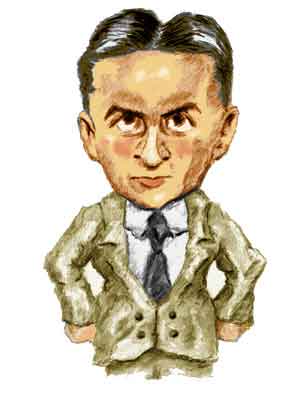
Eliot
Ness
Not Robert Stack; Not Kevin Costner; but Eliot Ness.
The REAL (Not REEL) Eliot Ness
A Most Merry and Illustrated History of The Untouchables and After

Eliot
Ness
Not Robert Stack; Not Kevin Costner; but Eliot Ness.
Beginning on April 20, 1959, Eliot Ness and his incorruptible band of "Untouchables" began blasting their way to truth, justice, and for the most part, reducing court costs considerably since anyone Eliot attempted to arrest would inevitably get blown away. Each week the supercops battled the supercrooks who were all led by (or at least in cahoots with) the insidious Frank Nitti, who although killed in the first season, kept coming back. To the post-war generation, there was no question but that America's top cop was Eliot Ness.
The show "The Untouchables" was produced by Desi Arnaz and Lucille Ball (yes, the stars of "I Love Lucy"). Making a star of Robert Stack, it ran for four years. Narrated by the staccato machine gun diction of the authentic gangster era newspaperman and radio announcer Walter Winchell, it had a combined documentary/film noir feel that beat the pants off goody two shoes shows like "Lassie" and "Leave it to Beaver". The last Untouchables show was aired May 21, 1963.
Eliot might have faded from the pantheon of American heroes except that in 1987, a little known actor named Kevin Costner was teemed up with movie icon Sean Connery in what became one of the biggest film blockbusters up to that time. "The Untouchables" (aka "The Untouchables - The Movie") revived interest in Eliot. Naturally the networks tried to milk just a little more blood out of the early hit show turnip, and in 1991 Robert starred in the TV Movie "The Return of Eliot Ness". It was even more fictionalized than the series OR Kevin's movie. Attempts in the 1990's to revive a latter-day Untouchables series came to nought, but to a whole new generation, Eliot was once more America's top cop.
Of course, everyone knows - or at least USED to know - television and films often play fast and loose with the truth. So when the trash 'em / splash 'em journalism became fashionable, any hero was a natural target for the exposés of what the guy (or gal) was REALLY like.
Sure enough, in 1961 the first article about the "real" Eliot Ness appeared in Coronet magazine. Or rather, it was the first article after people had forgotten that between 1929 and 1946 a LOT of articles had been written about Eliot Ness. But those early articles didn't count - they were, after all, newspaper stories about a real human being named Eliot Ness who just happened to be in the news. But even the Coronet article, written AFTER Eliot became a legend, was hardly a tell-all shocker. Except for adding a few new tidbits (like how the real Eliot hated guns), it kept up the line that Eliot was an incorruptible battler against the evil forces in America. Of course, that would be expected since the writer, Oscar Fraley, had been the co-author of Eliot's book, "The Untouchables" which had originally appeared in 1957 and was the basis of the series.
But in the 1970's, after Americans learned their presidents COULD be crooks, and that even the dashing JFK fiddled around with movie stars and swapped mistresses with Mafia warlords, "revisionist" history became the vogue. Suddenly people began to trash Eliot, pooh-poohing his reputation and accomplishments. Now everyone learned that the book was a bunch of hooey and Eliot was only minimally involved in the fight against Al Capone.
But of course, then we had the Reagan years and suddenly it was all right for Americans to feel good about themselves. That (and more comprehensive and objective research) has pushed the pendulum back a bit. Once more it's all right to believe the real Eliot Ness was an honest and dedicated public servant and he really DID make strides in fighting Al and cleaning up the cities. So the consensus (for now at least) is that Eliot DID pretty much live up to his legend, at least as much as could be expected for a real human being.
Contrary of popular belief, Eliot was NOT in the FBI. He was an agent in the Treasury Department, and there is the story that once the TV show became a hit, J. Edgar Hoover became irritated at seeing Eliot fighting killers, bank robbers, and kidnappers. That was the prerogative of Edgar's beloved G-men, not Treasury's T-men. You would think, though, that Edgar would have had more important things to worry about. But the truth is that Edgar worried about a lot of things he shouldn't have, and besides, he hadn't liked Eliot even before Eliot became a legend.
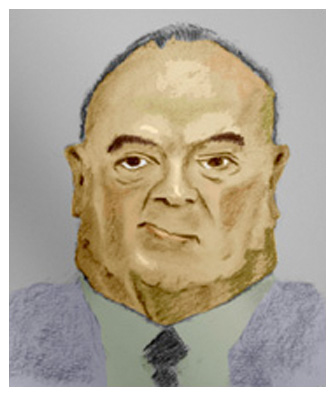
J. Edgar Hoover
He didn't like Eliot even before Eliot became a legend.
Eliot Ness was born in Chicago on April 19, 1903, the youngest of five siblings. Eliot's dad had risen from being a poor Norwegian immigrant to becoming the prosperous owner of a wholesale bakery. Although his dad was about fifty years old when Eliot was born, there was not much of a generation gap, and Eliot got along very well with his relaxed and easy going parents. The only thing that worried his mother was that Eliot was TOO good. She was flabbergasted that he never got into trouble, and as a student, he studied hard even though his recreational reading tended toward stories about cops and robbers.
From the start there was never any question but that Eliot had the brains and wherewithal to go to college. He did attend - and even excelled - at the University of Chicago, but it's also true that his academic achievements have been a bit overblown. He did NOT get a law degree (as some articles state), nor did he get a Ph. D. (as his own book implies) nor was there ever a master's degree in criminology (which some people also claim). But he WAS very well educated in a day when high school was a luxury, and in 1925 he ended up with a bachelors in business administration and political science. Whether this was two degrees or somehow a single combination isn't clear.
But from the first it seems Eliot was interested in law enforcement and while working on his first job for a company doing credit checks, he DID take a course in criminology. He also took up jiu-jitsu (that was long before karate became the craze) and he practiced and became an expert marksman. Then in August 1926 Eliot joined the Bureau of Prohibition which was part of the Treasury Department.
Some people have wondered why a young man with Eliot's credentials would take such a relatively low paying and dangerous job when he could have stuck to private enterprise and had his pick of any number of lucrative positions. Well, in the first place, the jobs available were NOT that lucrative, and a government job would be a step up in both pay and security. And believe it or not, for some people money isn't everything. Besides Eliot hated sitting behind a desk.
As far as his work as a treasury agent went, Eliot really was as honest his silver screen counterparts. But there is some truth in the depiction of Eliot as being pretty rough and tough. In the series Robert would occasionally smack around the crooks ("You sure you're a fed?" the crooks would whine) and in reality it wasn't unheard of Eliot to deal even more severely with the various miscreants. One even claimed that Eliot and his partners kicked him in the "b----" (this is, after all, a family website). But he did NOT threaten to fake evidence like Robert did on the tube, and he SURE as heck didn't throw Frank Nitti off the roof of the courthouse where Al was on trial like Kevin did in the movie.
It is, though, an indisputable fact that in the book, "The Untouchables", Eliot and Oscar played fast and loose. There is even a letter from Oscar to Eliot that has the bald face statement that there would be some manufactured "gangbuster" stories to make the book more exciting.
So the historians have had trouble sifting the truth from Oscar's and Eliot's fiction. Some of the more famous stories (like Eliot parading the confiscated booze trucks around Al's headquarters) have absolutely no documentation and no one else ever reported they happened. The book also covered up what were for the time some of Eliot's embarrassing personal problems. Naturally this has led to a number of misconceptions about Eliot.
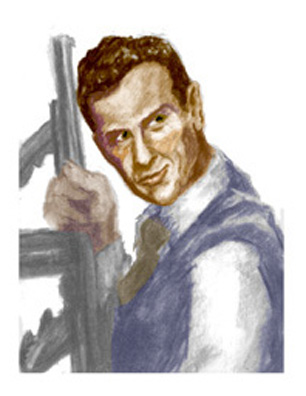
Robert Stack whose dark hair and larger than average nose closely resembled Ness..
First, put it out of your mind that Eliot never took a drink. He was, in fact, a "wet", that is one of the many (sc. the majority of) Americans who opposed Prohibition. Eliot, like most Americans of the era, would drink if the occasion arose regardless of the law. But he saw his role as a Prohibition agent as one fighting organized crime and the murder, gambling, and extortion rackets that went with it. He was NOT fighting drinking per se.
Also there is one article that said the actor Robert Stack "closely resembled Ness". That too is stretching it a bit. Certainly, they both had dark hair and noses a bit larger than average, but there the resemblance ended. Although he was by no means homely, even the most generous Untouchables fan has to admit the real Eliot did not have the classically chiseled leading man features of Robert. In some photos Eliot even seems to have a bit of a weak chin, something that Robert with his rugged good looks did not.
In the book, readers also learned that Eliot met his wife, Betty, at a fraternity dance at the U of C. In the TV show Betty was also mentioned a couple of times, and in the Kevin Costner/Sean Connery movie, Eliot and Betty even had a newborn babe. Clearly you had to admire Betty who had to live with a man whose idea of a good day's work was trading lead with some of Al Capone's leading henchmen.
Sorry folks. The truth is that Betty was Eliot's third - yes that's his third - wife, and they married in 1946. That was nearly fifteen years after he had bested Capone. In fact, when Betty married Eliot he had abandoned law enforcement altogether. Also none of Eliot's marriages produced children, and Betty and Eliot's son, Bobby, was adopted.
With all these smokescreens thrown up by everyone (including Eliot), the standard line used by the Eliot Detractors (and he does have them) is the real Eliot Ness was a glory seeking windbag on his good days and a lying alcoholic and womanizing scoundrel on his bad ones. He did NOT, they say, pull all those raids on the warehouses, breweries, and distilleries. Shoot, he wasn't even the most important agent in the fight against Al Capone. The man we SHOULD be lionizing is IRS agent, Frank Wilson. After all, it was Frank who ultimately proved that Al wasn't paying his income taxes, and THAT's what really nailed him. So Eliot, the Detractors scoff, wasn't even needed.
Well, really, we can afford to be a bit more generous here. Certainly if you read about Eliot it's hard to deny that he loved the limelight and that his dealings with others could be assertive to the point of being brash. Tact and modesty were not his strong points, nor in his job were they necessarily a virtue. And yes, his superiors sometimes expressed concern that their new gung-ho agent was out to make a name for himself. But otherwise Eliot's records show that his superiors were highly impressed by his energy, ability, and above all, his honesty.
First and foremost, though, Eliot and the Untouchables WERE important in getting Al - VERY important in fact. It was, after all, their job to prove Al was violating the 18th Amendment of the US Constitution and the Volstead Act, which was the federal law enforcing the amendment. That is, Eliot was assigned to prove Al was making, transporting, and selling booze.
Oddly enough, although the Volstead Act - or more accurately, the National Prohibition Act - specifically stated that the provisions were to be "liberally" interpreted to prevent USE of intoxicating beverages (defined as having more than 0.5 % alcohol), there was really nothing that specifically said it was illegal to drink. You could NOT, though, "manufacture, sell, barter, transport, import, export, deliver, or furnish" booze.
Buy and drink? Maybe. Manufacture, sell, barter, transport, import, export, deliver, or furnish? No.
Whether you could possess it, though, was a bit iffy. The act did say you could NOT keep intoxicating beverages unless prescribed by a physician (and so we guess that a lot of people got sick between 1920 and 1933) or if you were a rabbi, priest, or minister and needed wine for sacramental purposes (and we understand why during the Depression church going showed a big upswing, too).
But then the law went on to say it was NOT illegal to have liquor in private dwellings provided you were using it only for your own use or for your guests. Nor, it added, could search warrants be issued for private homes. So on one hand we have a law that says it's "liberally" intended to prevent use of alcohol, but then implies that it's OK to have the occasional toddy at home. So what gives?
What gives is that from the beginning the Government knew it had screwed up. Both the 18th Amendment and the Volstead Act were EXTREMELY unpopular and so the government quickly added there would be a "hands-off" policy toward people making beer or wine for their own personal use.
But except for the home brewing enthusiast, most people didn't want the hassle of making their own brew. They just wanted to go out and buy it. Also in the 1920's America saw the first generation where the kids enthusiastically rebelled against their parents by adopting entirely new styles of dress and listening to new types of music (particularly if their parents hated it). And what better way to thumb your nose and Mom, Apple Pie, and the American Way than to drink booze provided by the greatest legacy of the "Great Experiment", the murdering mobs that soon became organized crime as we know it?
It was when the gangs started blasting each other (and sometimes innocent bystanders) all in the name of getting a drink that the government stepped in. That was particularly the case after the St. Valentine's day massacre, and supposedly Herbert Hoover personally told his Attorney General to get Capone.
Despite Eliot's and Oscar's claim that Eliot came up with the idea of the Untouchables - an independent group of agents reporting only to United States District Attorney, George Johnson - the idea had been kicking around at the upper echelons of the Prohibition Bureau for a while. It was chief investigator (and Eliot's brother-in-law), Alexander Jamie, who was told to put the plan into action. Although Alexander picking Eliot as the leader seems a bit nepotistic, no one in the department questioned that Eliot really was the best choice for the job.
Although there were a few false starts, ultimately Eliot's raids (and his testimony) did prove to the jury's satisfaction that Al was manufacturing, selling, transporting, delivering, and furnishing booze to a lot of people. But more importantly it helped confirm that Big Al had a substantial and illegal, but more importantly, an unreported income. So Eliot's work was intimately tied in with the work of Frank Wilson and his group.
This focusing on the tax violations was a deliberate prosecutorial tactic since charging Al with violating the widely unpopular Volstead Act might backfire. In fact, Al himself never denied he was making illegal booze and in interviews with reporters seemed to think it unjust that he was being hounded for providing what everyone - including, he said, most government employees - were drinking.
So the idea was to prove, not that Al was making booze, but that this rich fat cat wasn't paying his fair share to Uncle Sam. THAT might carry some sand with a hard working class jury. So the government stuck with the tax angle which was a good thing. Al never was convicted of Volstead violations.
Which still means that Eliot had to go on some hair raising raids against Al's breweries and distilleries. This put Eliot and his men in real danger, since Alphonse Capone, despite the Robin Hood mythology that he and a lot of Depression era gangsters enjoyed, was not a nice man.
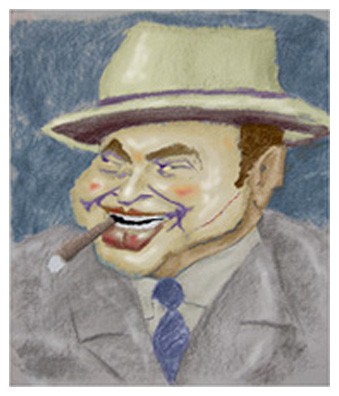
Al Capone
Affable and pleasant but not really a nice man.
Although according to reliable accounts of people who knew Al personally he could be affable and pleasant, all in all he was pretty nasty fellow. He had an unpredictable and explosive temper and he wouldn't hesitate killing someone for the slightest of reasons. His caddy (yes, Al played golf although not particularly well) once said Al almost shot a guy when the man suggested Al had moved the ball. Al yanked a gun out of his golf bag and the man literally fell to his knees and begged for his life. The same caddy also reported how Al simply watched in amusement as two of his golf foursome (again in a dispute about the play) got involved in a fistfight that was so bloody that the loser had to be carried off the course. So Al was not, repeat NOT, the type of guy you'd want to spend a pleasant afternoon with.
Naturally there are stories that Al demanded that Eliot be knocked off. However, once more it's not really known whether Al really put the "kiss of death" on Eliot or not, and the specific examples where Eliot told how he was ambushed are doubted by some historians. Others think that Al did indeed want Eliot dead. But wanting Eliot (or Frank Wilson) dead does not mean Al put out a contract for the agents to be hit. He very well may have decided to leave them alone.
To this day it's not known if Al himself personally killed anyone. The story of him whacking two men to death with baseball bats, although usually accepted as true, has (as you may expect) little hard documentation. But that he ordered men knocked off is a certainty. At the same time he wasn't stupid, and killing a law officer, particularly a federal agent, WAS stupid. It made things too hot, and that got in the way of business.
So crooks of Al's ilk sometimes preferred to take their chances that the feds couldn't build a case. In the end, though, Al's luck ran out. He was convicted, not of bootlegging but of tax evasion, but only on five of the 22 counts. None of the counts involved the Volstead Act, despite what you may read. Tax evasion was also a fairly new-fangled crime, so his fairy light sentence of a total of 11 years is understandable if not particularly satisfying. The even shorter time served - seven years - is also understandable since when he was released in 1939, neurosyphilis had reduced his mind to that of a cranky four year old.
In any case, when it came time for someone to write a book or make films about the Battle Against Big Al, no one could figure how to make an adventure story about Frank Wilson doing cash flow analysis. But smashing through doors and walls of speakeasies and breweries COULD be made exciting, especially if you threw in a few fictitious gun battles to boot.
And they were fictitious. Although Eliot's raids were hazardous and harrowing, he and his men did not enter the breweries with guns a-blazing. Although Robert might have routinely blown away about thirty-five of Capone's henchmen each episode, Eliot himself never shot anyone. In fact as is typical for most real life law enforcement agents, Eliot never - that's NEVER - fired his gun in the line of duty. Well, maybe once. During one raid the Untouchables found the door shut tight, and Eliot shot the lock off. Or so the story goes.
But perhaps the biggest misconception is that the Untouchables kept fighting crime long after Al went to prison. Under Robert's gritty leadership, the Untouchables took on gangs of all stripes and sizes all around the country. Whether it was Detroit's sophisticated and ruthless Purple Gang or just Oklahoma hicks like Ma Barker and her Boys, Eliot was there. If you believe the show, Eliot (or rather Robert) was even at that last gun battle in Ocklawaha, Florida (try saying that fast six times) where Ma Barker was killed. She even lobbed a grenade at him! Boy, Ma was one tough cookie!
Even if we ignore that Alvin "Creepy" Karpis (who was part of the gang) said the story of Ma's blasting the G-men with her Tommy gun was concocted by the FBI to cover up the fact they had shot down an old unarmed lady when they were trying arrest one of her boys, the real Eliot would have had no business going after kidnappers and killers. That was what the FBI was for, and Eliot was not - repeat, NOT an FBI man.
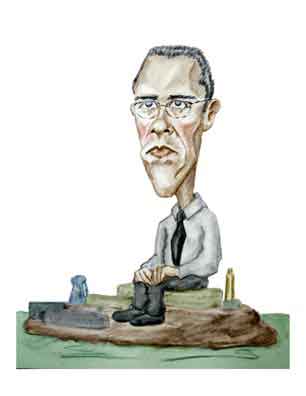
Al Karpis
"Old Creepy".
One final myth from the series is that Eliot's active nemesis was Frank Nitti, not Al. Using Frank so heavily in the series may seem curious since in biographies of Al, he seems more of a peripheral character. But here, at least, there is some basis in fact. Although Ralph Capone, Al's brother, is sometimes seen as Al's #2 man, once Al went to the hoosegow, the control of the Chicago mob, at least in name, went to Nitti.
On the show, Frank, was played by actor Bruce Gordon as a high-living and tough-talking gangster who somehow lost his Italian accent after the first couple of shows. He even took over Al's chair once Al went to prison. All this was more or less what really happened if you forget the part about his accent.
The real Frank was a former barber who got the name "The Enforcer" because that's what he did. Bruce, in the series, played the enforcer part to the hilt, portraying Frank as a blustering brutal killer who dealt with any opposition with the barked out phrase, "You're DEAD!"
The real Frank was as merciless as his celluloid counterpart, but was quiet and nervous, even jittery. Despite his nervousness (or probably because of it), he also took care of himself. Frank's first criminal charge occurred after he was 42 when he got convicted, like Al, of income tax evasion. Frank served only 18 months, and the short sentence was officially because he cooperated with the government. But he couldn't have cooperated too much since when he got out he continued to run the old Capone mob.
Frank's big claim to fame, if you want to call it that, is with Prohibition over, he sent the mob into the labor racket. He took over many unions and ruined thousands of workers by driving their employers out of business. His most notorious activity was when he tried to squeeze money out of Hollywood. He demanded (and got) hundreds of thousands in yearly payoffs from the studios and theaters, and was patting himself on the back when a newspaper reporter blew the story. Then everyone, including the heads of the studios, made a mad dash to the prosecutors to turn state's evidence.
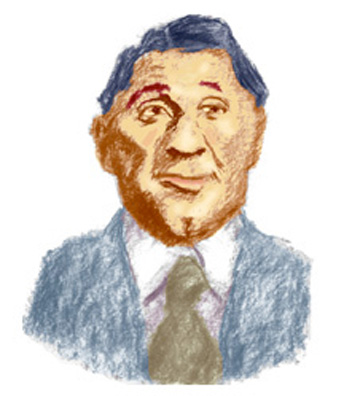
Frank Nitti
The Big Baddie after Al.
Frank's friends, including ganglord Paul Ricca (who some writers say was the REAL big boss), were ticked off at Frank's bad judgment. Since all this Hollywood stuff was HIS idea, they said, FRANK should be the fall guy. Frank demurred, but soon saw that no one was on his side. Finally, either realizing he was a marked man or that he was going to jail once more, on March 19, 1943, Frank walked out to Chicago's railyard and shot himself.
During most of Franks' tenure as the Chicago mob boss, Eliot wasn't even working in the government. So why was Frank, not Al, the big baddie in the TV series?
There are two plausible and not mutually exclusive explanations. First, once the show went on the air, Mae Capone, Al's widow, sued Desilu Studios for using her husband's name without her permission. Mae lost the lawsuit, but having Frank as a stand-in for Al would make the issue a moot point. The second explanation is that Al and Mae's son, Sonny, went to school with and was on friendly terms with Desi Arnaz. If that's true, then keeping Al off-screen most of the time may have been something of an unofficial personal favor from Desi to Sonny.
The unvarnished truth is that Eliot and his Untouchables only fought Capone and they worked in and around Chicago. Once Al went off to prison, the Untouchables were disbanded. Still, all in all in the government's fight against Capone, Eliot had acquitted himself with distinction.
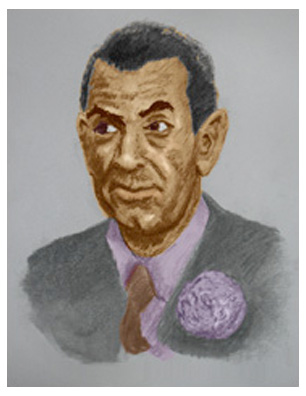
Bruce Gordon as Frank Nitti
Was it a personal favor for Sonny?
Al was convicted in 1932 and by 1934 he had been transferred to Alcatraz. Between that small gap in Al's life, Prohibition ended. The Prohibition division of Treasury was absorbed into the IRS, and eventually became the Bureau of Alcohol, Tobacco, and Firearms. The need for the old style prohibition agents was gone, and the agents were more and more assigned to hunt the small time rural moonshiners.
Which was Eliot's next job. Eliot found himself covering the hills and hollers of Ohio, Tennessee, and Kentucky. Actually this job turned out to be more dangerous than hunting the Chicago mob since the mountain men had no hesitation plugging the government "revenoorers" who came snooping around, something the city gangsters had always been cautious about doing. But once more Eliot acquitted himself well, and was quickly promoted to Inspector in Chief for the Alcohol Tax Unit in Ohio.
Then in 1935 Eliot was offered and accepted the appointment as Public Safety Director in Cleveland. At this time he had an outstanding record and reputation, and when he arrived the newspapers trumpeted that the man who beat Capone would be cleaning up Cleveland. Eliot's high standing reportedly angered J. Edgar Hoover who already thought Eliot had too much publicity and had refused to consider him for the FBI.
Eliot took to the his new job like - no joke intended - gangbusters, doing everything from stopping major police and political corruption to drastically reducing traffic accidents. He really busted his rear end and never hesitated to go after a crooked cop, no matter how high up. Eliot would himself lead raids on the illegal gambling joints that were run by the sleazy politicians and that were protected by crooked cops. And he rarely, if ever, carried a gun.
By booting out the crooked cops, Eliot was also able to bring in major administrative reforms. He made it possible for officers who showed particular ability to rise faster through merit than had been possible on the old seniority system. And at a time when many policemen started off just by donning a uniform and walking a beat, Eliot initiated a three month training program for new officers. This ultimately became the Cleveland Police Academy, which today is one of the best in the nation
In Cleveland Eliot more than confirmed his reputation as an honest crime buster. But it was also in Cleveland that Eliot also proved he was a human being. Not only did Eliot drink, but he was quite the party animal. He was known to stay at nightclubs far into the wee hours, and ironically, one of the best veterans from the Bureau of Prohibition began to develop a drinking problem which shadowed him the rest of his life.
Word also is that he also showed a lighter side with the ladies, and Eliot's first two marriages ended in divorce. To be fair, Eliot's marital problems were probably due to his workaholic philosophy, and there's no indication that he did any overt fiddling around. But it can't be denied that many women seemed to take to Eliot and when separated from his wives, he was often seen playing the field. None of this set particularly well with many of Cleveland's more staid and censorious citizens. But for a number of years, Eliot's undoubted ability kept the criticism at bay.
But no law officer - that's NO law officer - is as successful as the legends make it, and eventually reality catches up with them. Sooner or later even the best cop will loose or blow a case. If so, well, that's the way it goes, and the good smart cops will just go on to solve the next crime.
But the big boss can't always do that and Eliot's major setback as a crime fighter came about because of what became known as the "Kingsbury Run Murders". Between 1934 and 1938, a series of mutilated (and decapitated) corpses began showing up in and around Cleveland. The total number of those killed officially was twelve, although similar killings in cities within traveling distance could easily push the number to twenty or even higher. Although the crimes were even more horrifying than London's Jack the Ripper killings fifty years earlier, today virtually no one's heard of them. Perhaps the Whitechapel Murders of London just has a ring to it that the Kingsbury Killings of Cleveland doesn't.
For some reason initially Eliot kept himself at an arm's distance (no sick joke intended) from the investigation, preferring to leave the work to Cleveland's able detectives (and there were some good ones). After all, Eliot himself was not trained in murder investigation and probably recognized that this was a situation that Cleveland's own homicide squad could handle better than he could. But as more and more bodies kept showing up, people began demanding that, dang it, the man who bested Al Capone should DO something!
What was worse the killer seemed to be taunting the police. Once he neatly put parts of a body in a basket to make it easier for the cops to find, and later he dumped another victim practically in view of Eliot's office. After four years, about all Eliot had to show was that he had burned down the Kingsbury Run shanty town which housed the itinerants and hobos that drifted around during the Great Depression. The press smacked Eliot pretty hard for this, saying burning down the hovels of down-and-out drifters was not going to solve the murders. Strictly speaking, that was true. Eliot didn't catch the killer, but it was about this time that the murders - officially, at least - did stop.
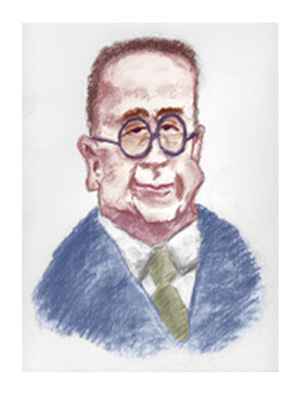
Dr. Frank Sweeney
Eliot's First Choice for a Psychopahtic Killer
But that doesn't mean the authorities were necessarily stymied. And there were suspects. Today the most popular choice is probably Dr. Frank Sweeney, an intelligent and prominent, but alcoholic and mentally unstable physician. To be fair, historical opinion is not unanimous, and Eliot never mentioned the doctor by name. But it is now generally accepted that Frank was Eliot's first choice for the psychopathic killer.
Although he looked like a cross between Casper Milquetoast and a chubby Arnold Stang, Dr. Sweeney had been a problem for his family for years. He was a big man, and as his drinking got worse his temperament tended to become fractious and even violent. Eventually he passed most of his time either drinking or pretending to dry out in any of the various clinics that treated alcoholics and drug addicts.
It's not likely, though, he would have been fingered except that one of the hospitals where Sweeney was being treated shared facilities with a minimum security prison. There the affable Dr. Frank had made friends with one of the prisoners, and at one point he had asked the man a number of questions such as where he was from, did he have plans after he got out, did he have any relatives, etc. In other words, he asked exactly what a smart serial killer would ask if he was looking for a victim.
At the same time, some of the investigators had concluded that a killer who could slice people up with such anatomical aplomb might be a physician or a medical student. Given the nature of the crimes, they further reasoned that the killings were likely carried out in the throes of an alcoholic or drug binge. So the well-known Dr. Sweeney was a natural suspect.
One of the detectives discretely began talking to people in the hospital and at the prison. When he learned Frank had been possibly canvassing for victims - and also that he could come and go from the hospital at any time - he reported his findings to his superiors, and ultimately to Eliot. But Eliot had to tread lightly here since the good doctor was a cousin of one of Ohio's congressmen.
Eliot was discrete, but he was also determined. He gave Dr. Sweeney two choices. Either he could come in secretly and submit to a polygraph test, or they would haul his rear end down to the station in full view of the public, with flashbulbs popping and reporters in tow. The doctor accepted the former offer.
Sure enough, Sweeney failed the polygraph test, not only once but repeatedly. Eliot was convinced they had the killer. But then as now, lie detector evidence isn't admissible in court, mostly because when you get down to it, lie detectors don't always detect lies. So when he was confronted by Eliot, the doctor just sneered and told him to prove his case. Sweeney's manner became so belligerent that Eliot later said he had never felt so threatened in his life.
In the end no one was ever convicted for the Kingsbury Run murders. But possibly on a semi-deal with Eliot, Dr. Sweeney committed himself to a mental hospital. As his confinement was voluntary, he could still leave at any time, and Eliot demanded that if Sweeney left the premises, he darn well would be told.
Frank kept razzing Eliot by sending him taunting postcards, and eventually he transferred to a Veteran's Hospital in Dayton where he died in 1965. Finally in one of the strangest codas ever to a series of brutal murders, the whole thing was put into - get this - a musical comedy. It hasn't done too well, but you can bet Dr. Frank would have loved it.
For Eliot the failure to resolve the Kingsbury Run murders coincided with the start of a slow and at first almost imperceptible slide downhill. The true beginning of the end happened on the morning of March 5, 1942. Eliot, his second wife, Evaline, and some friends had been partying at one of Cleveland's hotel nightclubs. At 4:30 they left to go home. The road was icy and as Eliot rounded a curve, the car went into a skid and plowed into an oncoming car.
At this point there are a couple of versions of what happened. In one story (Eliot's) Eliot got out and saw the other driver was slightly hurt. He suggested they both drive to a hospital, but somehow they got separated and so he went on home. In another version, when a third car showed up at the scene, the injured driver was still in his car, and Eliot was nowhere to be found. At the hospital, the driver gave a description of the missing car, along with its license number. The car was indeed Eliot's, and when the investigating officers got to interviewing their Public Safety Director, Eliot - slipping a bit from the pristine level of integrity that had so far served him well - suggested the officers sweep the episode under the rug.
That was a bad move for a man who made almost a fetish of rooting out corruption, particularly since the officers' boss was one of the guys Eliot was trying to nail. Gleefully, the man called the papers and let it be known that Eliot - yes, that's right, Eliot, squeaky clean Eliot, the Untouchable - had been involved in a hit and run accident after a night out on the town. The insinuation, of course, was that Eliot was potted and left the scene to keep from being found out. Eliot denied he was under the influence, but a lot of people had seen him that night, imbibing drinks most generously. Within three weeks, Eliot had resigned his position as Cleveland's Public Safety Director. Then he and Evaline pulled up stakes and moved to Washington, D. C.
The Three Misses Ness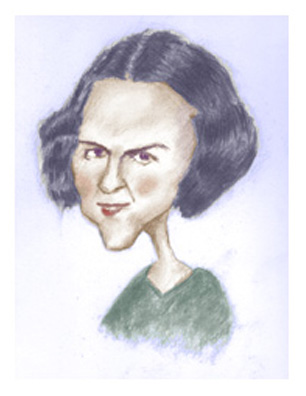
There's Edna ...
Eliot was married three times. He had known his first wife, Edna, since grade school, but first asked her out when she was the secretary to Alexander, his brother-in-law and fellow Prohibition agent. The marriage lasted from 1929 until 1938 and for the most part, you can pretty much substitute the name "Edna" in place of "Betty" in the book.
The main problem with all of Eliot's marriages (even his last successful one) was his dedication to his job. He was a real workaholic and had no concept whatsoever of regular working hours. Although this is surely a tribute to his dedication, it was a pain in the rear end for his wives. In the first flush of marriage when most wives think their hubbys are wonderful, they can put up with a lot. But after a few years their tolerance drops once they realize they've married an airhead.
By 1937, Edna and Eliot's relationship was fractious enough that Eliot moved out, and Edna filed for divorce on the grounds of "abandonment" and "extreme cruelty". But this may have been simply standard legal lingo in a day where divorces were harder to come by. Today they probably would just used "incompatibility" as the reason for the split. We hope.
Evaline, Eliot's second wife, was an established artist and illustrator and they were married in October 1939. She had every intention of continuing her career. But she soon found that being married to Eliot put a bit of a crimp in her plans as she found herself having to play the part of hostess and socialite in both Cleveland and later in Washington.
In Washington, once more Eliot found himself working for the federal government. From the modern vantage where the Myth of Eliot prevails, it can be something of a jolt to learn that the man who went up against THE worst gangster of the Prohibition era, bar none, was now striving to keep venereal disease out of the military. But that's exactly what Eliot was doing.
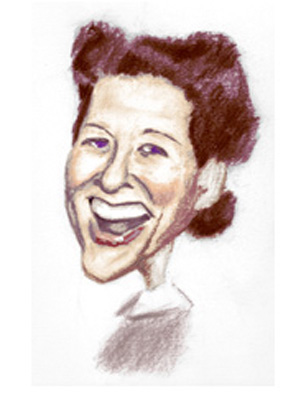
... Evaline ...
The job entailed a lot of travel and that, plus Eliot's work ethic, once more put a strain on what was probably already a bit of a rocky marriage. Evaline really did want to work as an artist and fashion designer, and finally in 1944, she suddenly moved to New York leaving Eliot behind. In a year the divorce (this time initiated by Eliot) was finalized. By then or shortly afterwards, Eliot had met Betty Anderson Seaver, who had also been married previously. Like Evaline she was an artist (a sculptor), and in 1946 she and Eliot were married. Soon they adopted Bobby and by all accounts Eliot was a doting father when his time permitted.
Living in Washington gave Eliot a number of important contacts, and he soon became involved in some business ventures with Washington's rich and famous, including one with craggy faced Air force general Claire Chennault. He also became an executive in the Diebold Corporation (which is still going strong today). But unfortunately Eliot style of management, although serving him well for fighting crime and rooting out corruption, wasn't so great when trying to schmooze out a business deal. Finally he was dropped from both companies. Then in 1947 and in what was probably the biggest mistake of his life, he moved back to Cleveland to run for mayor.
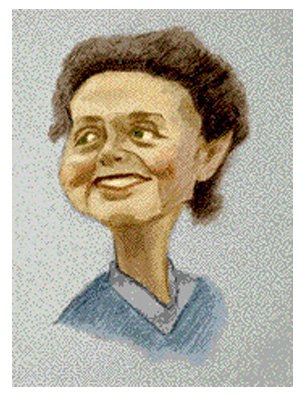
... and Betty.
Although it had been nearly a decade since the last of the Kingsbury Run murders, the citizens of Cleveland had not forgotten Eliot and his number one failure. To say he was not the favorite candidate is a whopping understatement. Some people, anticipating the taste and courtesy of political campaigns of the late twentieth and early twenty-first centuries, expressed their displeasure with his candidacy by hanging parts of mannequins around town. Eliot lost the election in a landslide, and since a good chunk of his campaign financing had come out of his own pocket, he now found himself in debt, out of work, unpopular, and literally with no place to go.
Eliot remained in Cleveland and flitted from job to job. He worked for two wholesale companies, one selling electronic equipment; the other peddling frozen hamburgers. None of these ventures led to anything, and at one time he was even reduced to clerking in a bookstore. It had been a long hard fall.
Eliot finally hooked up with the North Ridge Alliance Corporation, a small company based in Cleveland which looked promising. The idea was the company would produce and sell forge-proof checks which would (embossed via a patented procedure) carry a special watermark. Then one of the partners absconded and tried to set up a rival corporation. Worse, the patent they were trying for was denied since other companies were practicing similar technology already. Still, Eliot and his partner, Joe Phelps, decided to make a go of the company. To cut costs, they moved from Cleveland to Coudersport, Pennsylvania, a small town just south of the New York border.
Eliot's salary - about $600 a month - wasn't much for a corporate president. But in the early 1950's it was certainly enough to support a reasonably comfortable middleclass lifestyle, especially up in the Pennsylvania hinterland. Eliot and Betty found the town peaceful and congenial and except for the worry of their holdover debts, they were perfectly happy. Even into the twenty-first century, there were residents of Coudersport who remembered Eliot, and they all said nice things about him.
None of the townspeople knew the new pleasant and innocuous businessman had once been one of America's top cops, even though Eliot would often stop by a bar on his way home and tell his stories about how he had fought Al Capone. No one believed him, of course. Good old Eliot!
But Eliot's closest friends knew. On a business trip to New York, Eliot and Joe Phelps met up with one of Joe's friend, sportswriter Oscar Fraley. One night as the men sat around shooting the bull, Joe turned to Oscar and said he should get Eliot to talk about his days as a Prohibition agent. He actually fought Al Capone, Joe said. It was pretty hair raising stuff. After listening spellbound for the whole night, Oscar said Eliot should write a book.
At first, Eliot didn't seem all that interested, but later Oscar convinced Eliot to let him look over his old scrapbooks and records. Oscar would do the actual writing, he said, and if things went well, they might have a bestseller on their hands. Eliot told Oscar to go ahead.
By 1957, the book had been written and accepted for publication. When Oscar told Eliot, he thought they might make a lot of money, Eliot said he could use it.
On May 16, 1957 Eliot came home from work and said hello to Betty. He walked into the kitchen, turned on the faucet to get a drink of water, and dropped dead of a heart attack. He was 54.
Eliot left no instructions for his burial, and he was cremated. For years Betty kept his ashes. When Bobby left home and got married, he took his father's ashes with him.
Bobby died in 1976 from leukemia at the age of thirty. Betty followed the next year. She was seventy-one. From then on other relatives held on to Eliot's ashes, and no one quite knew what to do with them.
When Eliot's first serious biography appeared in 1997, some of Cleveland's city fathers read about Eliot's unquiet remains. They contacted Bobby's widow and finally, on September 10 of the same year, and in a special ceremony sponsored by the city, the ashes of all three family members were scattered at Cleveland's Wade Lake in Lake View Cemetery. A memorial marker for Eliot, Betty, and Bobby was placed at the site.
Despite Oscar's hopes, the initial sales of "The Untouchables" had been sluggish. But a year later Desi Arnaz got the option to produce a TV movie and later ABC agreed to carry the series. The rest, so everyone says, is history.
References and Bibliography
'The Untouchables", Eliot Ness and Oscar Fraley, (Julian Messner, Inc. 1957). Eliot's own account, or rather it's Oscar's and Eliot's account. They tidied up Eliot's private life (like leaving out his first two wives), and they (or at least Oscar) spun some episodes out of the whole cloth. Although a good book, well-written, and entertaining, it's still very difficult to tell if any given episode should be believed.
Eliot speaks highly of Capone's intelligence and enterprise, but not so highly of his morals. From first edition hardbacks to trade paperback, many and cheap copies are available.
"Eliot Ness: The Real Story", Paul W. Heimel, (Cumberland House Publishing, (Revised 2001). An excellent and thorough biography which also includes what "The Untouchables" left out, which is essentially the last quarter century of Eliot's life. Again readily available.
"Eliot Ness and the Untouchables: The Historical Reality and the Film and Television Depictions". Kenneth Tucker, (McFarland & Company, Inc., 2000). Just what it says, The Truth vs. Popular Culture. Television may be more fun, but the truth is ALWAYS more interesting. A nice chapter on the real Eliot, the real Al Capone, and the real Frank Nitti, plus discussions on what made the television show click.
Copies are not super cheap, but they are affordable.
"Torso: The Story of Eliot Ness and the Search for a Psychopathic Killer", Steven Nickel. ( John F. Blair, 1989). Rather gruesome story, but essential information for the student of Eliot Ness.
"Mr. Capone: The Real and Complete Story of Al Capone", Robert J. Schoenberg (William Morrow and Company, 1992)
"Capone: The Life and World of Al Capone", John Kobler. (G. P. Putnam's Sons, 1971)
The two standard biographies of Al. They do mention Eliot largely in a positive light. But they do try to put his contributions in proper perspective.
"After Capone: The Life And World Of Chicago Mob Boss Frank 'the Enforcer' Nitti, Mars Eghigian, (Cumberland House), 2005.
From around the mid-30's to the 1950 was the time that there was the transition from the old Prohibition Gangster to the new era. It's sometimes forgotten that many of Capone's contemporaries and buddies, like Paul Ricca, Sam Giancana, and Tony Accardo lived long enough to influence the world as we know it today. Frank, although not making it to the post-Camelot era, was in on the beginnings of the modern mob.
How many people know Frank's real name was "Nitto", and "Nitti" was just because the newspapers couldn't get it right?
Internet Sources
Internet sources are often unstable, unreliable, and short lived. But some that will probably be around for a while are:
"Al Capone's 1931 Indictment", http://www.drbilllong.com/CurrentEventsVI/Capone.html
A detailed and easily understood explanation of Al's indictment.
"Eliot Ness in Cleveland", http://www.clevelandmemory.org/ness/
Hosted by the city of Cleveland, there are a number of good photos of Eliot and his family, including Edna, Evaline, Betty, and Bobby.
The Crime Library
Sadly as bedivils the Internet, this site has undergone so many changes that the original sources are no longer available. The site still exits but in a reduced form as part of the Crime Museum.
Return to Eliot Ness Caricature
Return to CooperToons Caricatures